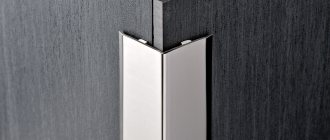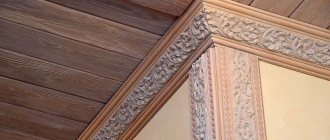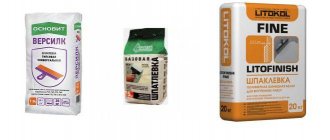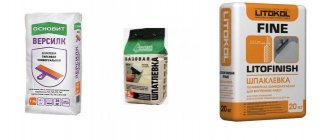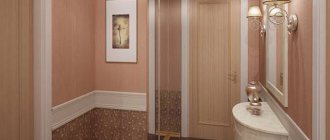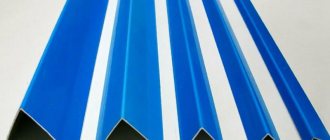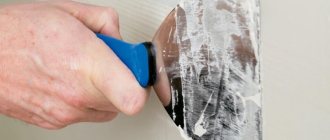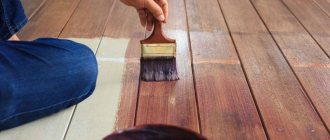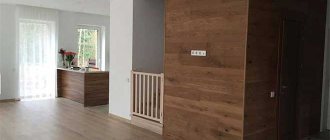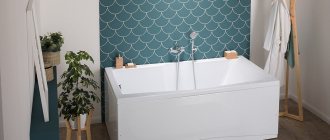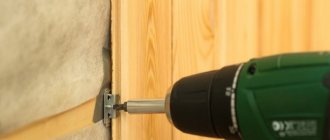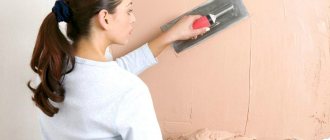Finishing work on the wall surface is completed not at the moment of gluing the wallpaper or covering it with decorative plaster, but when plastic corners are glued to protect the corners of the wall. After all, without them, there remains the risk of defects appearing too quickly in the corners of the walls, as well as in the area of door and window openings. Wall corners are designed to secure these areas; there are a large number of them; more details about the range of these products will be discussed below.
How to glue a plastic corner onto wallpaper
First of all, decide on the number of products and the width of the shelf.
They are available in lengths of 2.7 meters. On site you cut the part - trim it. Corners are glued
They are cut with a paint knife, a hacksaw, or a grinder (metal blade). When joining planks at an angle, it is better to cut using a special miter box device. Apply the adhesive to the inside of the plank in a wavy snake pattern. Use the gun. Gently press the workpiece to the corner and, applying pressure, go over its entire surface with a clean cloth so that the adhesive mixture is evenly distributed inside the plank.
Everything should work out right the first time, so be extremely careful. Fix the strip with masking tape in several places. The next day the tape can be removed. If the corners are uneven, small gaps may remain in some places. If this is too noticeable, then carefully seal them with acrylic sealant, but it should not stain the trellises. I think you will decide how to glue the plastic corner to the wallpaper, since the correct choice of glue plays a dominant role in this process. High-quality adhesive composition and care when gluing will ensure aesthetics and long service life of plastic products. To reinforce the material, I offer a video on the topic.
What to attach to
The choice of method for attaching corners to protect the corners of walls depends on the material of the corner and on what surface they will be attached to. The most commonly used glue is glue. Moreover, “liquid nails” are among the leaders. This is a universal compound, but before purchasing, check that the specific brand can bond the materials you need.
You can put a corner on the glue if it is even, without large flaws. If there are holes/depressions, you are unlikely to glue it. In this case, you can use silicone. If you are gluing white corners, you can use white silicone. For colored ones it is better to take transparent ones. It is not advisable to use acidic everywhere. Although it is cheaper, it can damage metals or paint.
In both cases, the wall and corner must be clean and dry. The compound is applied to the corner, it is pressed against the corner, and fixed with strips of masking tape. We grab it after 40-60 cm. If everything is smooth, you can do it after 60 cm; if you need to repeat the shape, after 40 cm or even more often.
How and with what to glue a PVC corner to the wallpaper
Leave it in this state until the glue dries or the silicone hardens. See the packaging for the exact time. Then the masking tape can be removed. It differs from ordinary tape in that it comes off even from paper wallpaper without damaging the surface. But to be sure, try sticking and peeling in an inconspicuous place.
Foam rubber corner - L-shaped and universal with self-adhesive backing
There is another option for how to glue corners to a wall with wallpaper or paint. You can use double-sided tape. First glue it to the corner, then, after removing the protective coating, press it to the corner. There are corners to which the tape is already glued. Some types of foam rubber or plastic (usually flexible or universal).
Filling empty corners in the apartment
Not all corners require finishing and cladding. Most of the internal joints remain unfinished, but the free space in them is successfully filled with various decorative elements.
Corner decor
Shelves and racks
Triangular racks and shelves will help turn a useless empty corner in the apartment into a convenient place to store things. They do an excellent job of organizing space and don’t look bulky or heavy. On the shelves you can place your favorite figurines, awards, stylish accessories that complement the interior, or just cute things. The shelves are well stocked with books. Their types are extremely diverse:
- wall;
- floor;
- built-in;
- hanging;
- whatnots.
The most problematic rooms in an apartment in terms of storing things are the hallway, kitchen, and bathroom. It is here that most often residents do not know how to place all the necessary things compactly without compromising the appearance. Here are some tips: in the hallway, corner shelves can simultaneously serve as a hanger for clothes or a stand for shoes and bags, and in the kitchen they place small appliances and dishes.
Modern designers offer many unusual ways of arranging shelves in corners, as well as using them together with shelving. They can be continued on the walls, even running along the entire perimeter of the room.
Corner rack will accommodate many useful little things
An external corner shelf will house decorative elements and protect the walls from frequent contact.
Floor vases and flowers
Vases with a height of more than 40 cm are considered floor vases. Vases have been an item of luxury and prosperity since antiquity; today they also have the meaning of well-being. They are often used as decoration for expensive interiors. Floor vessels can be of different shapes:
- vase;
- pot;
- jug;
- bottle.
Corner decor
With different textures, from different materials, for example:
- ceramics;
- porcelain;
- tree;
- glass;
- metal.
Corner decor with lamp
It is better to give preference to heavier, unbreakable materials, but if you decide to choose, for example, a glass vessel, you can fill it for stability by pouring some stone (pebbles), shells or sand into the bottom. Also, expensive and especially valuable vases can be placed on special stands. Containers can be an independent decorative element or contain artificial or fresh flowers, natural and decorative branches, and bamboo stems. The filling of the vase can be changed depending on the mood, season and other factors. If one pot looks distant in the corner, you can add “companions” to it.
Fresh flowers in pots are an integral element of almost any home. Large and massive plants will successfully take place in the corner, filling the room with greenery and beauty, making it cozier and more comfortable.
A vase filled with natural or artificial branches will perfectly fill the space near external or internal corners, and will also decorate the interior Corner furniture
Such products have been in particular demand in recent decades, as they allow rational use of space. Corner furniture will look great not only in a small room, but also in a very spacious one, helping to get rid of empty, useless joints. First, kitchen sets gained popularity, but today all sorts of options are known: sofas, cabinets and even entire workplaces consisting of a computer desk, cabinets and shelves.
Corner decor
The walls will advantageously fill the free space and accommodate many useful little things, necessary gizmos and even equipment. Cabinets and walls in the hallway and living room will allow you to place even large items in this place and can easily replace a dressing room or storage room.
The corner sofa itself is larger than usual; it can accommodate more people.
An interesting design solution: in one move, a corner cabinet turns into a compact, comfortable workspace
Lamps and figurines
Lamps and figurines, successfully matched to a specific style, will complement the interior design. If you place them in the corners, this will significantly enliven the space and complete the image of the room. Lighting fixtures and various decorative figures can be placed absolutely independently in a corner or on any other structure (on a shelf, bookcase, chest of drawers, in a closet, etc.). If you decide to choose a floor-standing option, then the main rule applies - it must be stable enough for its size and “withstand” in the event of unexpected mechanical interactions with it.
Corner decor
Mirrors
A mirror in the corner will be an excellent option, as it will help to visually “smooth out” it, thereby filling the space, and will also create the illusion of additional expansion of the room. It can be independent or be an element of some corner furniture. It is advisable to use two narrow mirror sheets, which are mounted at the junction of adjacent walls, which will radically change the geometric perception of space. Floor mirrors and screens will be an excellent addition to the decor of corners in the bedroom and hallway.
Corner decor
Fireplaces and stoves
The fireplace in the corner can be fake or real. More often they install artificial ones, less often it becomes a full-fledged heating device that runs on electricity or biofuel in apartments or traditionally on wood in private homes. If there is no heating element, the inside wall can be made mirrored.
Corner fireplace with artificial flame, successfully placing decorative elements on itself
Other decor
Don't know how else to decorate the corner of the wall in the room? There are many other simple ways:
- an art gallery or a thematic selection of photos;
- all kinds of decorative elements attached to the ceiling (pendants, lamps, flower pots);
- a full-fledged place to relax, consisting of a small sofa, pouf, armchair, bean bag;
- cage for rodents or birds.
You can also place an aquarium in the corner.
Original finishing of the outer corner with a built-in aquarium
Finishing corners and arched openings with decorative corners
Arched plastic profiles stand out from the general range due to their different side sizes and flexibility. They are glued onto openings with smooth lines without cutting. Available in colored and decorative ones. To protect the corners, use a tone darker than the wallpaper or paint on the wall. The arch line appears more clearly, emphasizing the style of the interior. If the room has wooden floors and laminate flooring that imitates boards in its pattern, it is appropriate to choose decorative arched profiles imitating wood. Polyurethane corners receive their design and color during manufacturing. Dyes are part of the material. Additionally, laminated products are available to protect corners.
I choose the width of the plastic colored elements depending on the size:
- the arch itself;
- premises;
- ceiling height;
- the thickness of the wall in which the opening is made.
The larger the listed interior parameters, the wider the finishing of the corners should be. A narrow one can get lost among large elements. A wide one will look unnatural in a small hallway with a narrow opening and a thin partition.
Arched plastic profiles stand out from the general range due to their different side sizes and flexibility
Selection of plastic panels
In most cases, the choice depends on the project, taste and financial capabilities of the customer. One of the reasons for using them is that immediately after installation you can get a finished surface that does not require additional finishing.
This method is advisable to use for cladding rooms with a humid microclimate, such as toilets, bathrooms, and kitchens. Balconies, loggias, and dressing rooms can be decorated with plastic.
The advantages of many plastic panels are that they are resistant to weather conditions, and the decorative coating tolerates solar ultraviolet radiation well, which makes it possible to use this type of finishing for house facades.
Before covering a wall or ceiling with plastic panels, you need to measure them. It is good if the length of the sheet exactly matches the height of the room or slightly exceeds it. Otherwise, it will be necessary to add to the required size with the appearance of end seams. The greater the width of one element, the fewer seams between the side edges will be present on the surface area to be finished. The front edge of the PVC sheet for walls must have a flat and smooth surface without waviness in both the longitudinal and transverse directions.
Corners for protecting wall corners: selection options
This technique for decorating wall corners - protective corners - is not liked by everyone, but there are no special alternatives. In any case, on walls covered with wallpaper, a corner is still better than sticking out and torn canvases.
There is only one solution available for the integrity of the wallpaper without the use of decorative corners - to make a rounded corner rather than a sharp one. In this case, there will be no problem with finishing it. You can simply roll up the wallpaper without cutting it. But the corner must be drawn out perfectly, otherwise you will have to cut it again, which means that the question of protecting the wallpaper joint at the corner will again arise.
It is important to choose the right decorative corner so that it does not look alien. There are special techniques for this.
The interior looks good in the appropriate style
You need to select corners to protect the corners of the walls based on the overall design of the room. There are several standard solutions:
- To match the wall decoration. A complete color match is desirable, and even better if the texture is similar.
Either match the wall trim or match the doors
One of the options is quite logical
In general, you need to select corners to protect the corners of the walls depending on the design of the room. This can be done after the furniture has been arranged and textiles have been hung. In this case, it is easier to imagine the end result. Because the picture in our head can be very different from reality.
One of the transparent protective corners
If you just can’t find an acceptable color, and you need to protect the corners in your apartment, pay attention to the transparent plastic corners. They are of different types - rigid, flexible, with different wall thicknesses.
Decorating corners in an apartment: places of application
Corner profiles are used when repairing the following elements:
Door and window slopes
Traditionally, double-glazed windows are equipped with special corners that complete installation. The door kit also includes fittings and platbands. These elements protect the slopes from damage and have an aesthetic function.
If the corners are not closed, then selecting these elements yourself is not difficult. A suitable option is plastic corners. By choosing the required profile color, you will make the transition of a door or window opening smooth and less noticeable.
Horizontal joints of ceilings, floors and walls Corners for ceilings and floors are usually called plinths, and they are practically the same as corners for walls. Ceiling profiles can also be called baguettes, fillets or moldings.
A foam ceiling baguette is the easiest to install in an apartment
Such an L-shaped plinth necessarily has two flat and smooth surfaces that are attached to the ceiling and wall, and two front surfaces with a relief or ornament m. The fillets are fastened in different ways depending on the material; the foam baguette is, for example, glued to silicone or liquid nails.
One of the popular floor models is a plastic plinth with a collapsible design. The base of such a plinth is attached to a dowel-nail to the wall, then the front colored part is attached to the base using a special lock. Floor and ceiling profiles are made from various materials: PVC, polyurethane, dupolymer, wood, metal. Ceiling corners are also produced in gypsum and foam.
Corners of decorative partitions, openings, including arches
Popular doorways in apartments are semicircular arches. The contours of this design can be repeated by corners made of flexible plastic, veneer, MDF or bamboo.
Skirting boards for the bathroom are ceramic marble, plastic, acrylic, and there is also a self-adhesive border made of PVD and silicone profiles.
The easiest to work with and cheapest option is a self-adhesive border. Its only drawback is its service life, since such a corner needs to be changed after 1-2 years.
Joints of countertops and aprons or countertops and other objects.
Installation of any kitchen set is completed by installing corners at the joints of the countertop and apron. The plinth here not only has a decorative function, but also prevents water and food residues from getting behind the countertop, and also hides defects and damage that occurred during installation. new kitchen.
Kitchen profiles can be plastic, aluminum, wood, stone. Aluminum plinths are resistant to temperatures and chemical influences, plastic ones come in a variety of colors and designs, wooden and stone ones are environmentally friendly. The choice depends on various factors.
The shape of the borders is also varied: flat, curly, rounded, convex, or vice versa.
Vertical wall joints - internal or external
Wall corners, especially in walk-in rooms or narrow corridors, are often susceptible to accidental contact, friction or even impacts. They can be damaged by moving furniture, children or animals playing. This is why designers and/or owners decide to decorate the wall joints with decorative corners. However, corners are used not only for this purpose.
A transparent acrylic profile with ornamentation will complement the wallpaper design and make it sophisticated
Assortment of corner profiles at Krepkom:
Steel corner
This is a general-purpose shaped metal product with a flange width of 20x20 or 25x25 mm, produced on rolling mills from ordinary carbon steel. The L-profile has high bending strength and is easy to cut, drill, weld, and paint. It is used for the manufacture of welded metal structures, frames, racks, brackets, gratings, load-bearing frames. In construction, metal profiles can be used to reinforce reinforced concrete structures, as door and window lintels, and in the manufacture of canopies, gazebos, and fences.
Aluminum corner
The L-shaped aluminum profile, unlike steel, is lightweight and has high corrosion resistance. Color anodizing gives it different colors: silver, gold, bronze. Angular profiles made of aluminum are used for the manufacture of lightweight load-bearing structures, advertising media, and equipment for ships and aircraft. It has found application in ventilated facade systems, furniture assembly, and interior decoration. In our store, the size of equal-flange aluminum corners starts from 10x10 mm and ends at 40x40 mm. The length of the products is 1 or 2 m, and the thickness of the aluminum is 1-3 mm.
Brass corner
Corner profile made of brass is used as a protective and decorative element when finishing walls, floors, furniture, and doors. It is installed on the outer corners of tile coverings and stair steps. The noble color and shine of the decorative brass corner goes well with tiles, glass, mirrors and laminated slabs. Brass corner profile is sold in meter-long pieces with shelf widths from 6 to 20 mm, thickness from 0.8 to 1.5 mm.
Plastic corner
White and colored PVC corner - finishing material for window and door slopes, wall panels, lining, external corners of walls. For home renovations, the most popular protective corners are those with a shelf width of 15 or 20 mm. For their installation, polyurethane-based glue (moment), silicone sealant or liquid nails are used. A large selection of sizes and colors allows you to choose a finishing plastic corner to protect corners in any interior.
The Krepkom store has the best prices and a large assortment of structural and decorative corners for your project. Consultation with a specialist by phone. For our part, we guarantee prompt completion of the order and immediate delivery to the specified address in any region of Russia.
Options for using corner profiles for finishing corners
At first, most apartment owners are quite restrained about using corner profiles when decorating corners and wall junction lines. What hinders us, first of all, is the well-established classical opinion that the use of PVC materials in an apartment should be limited and used primarily in places where it is simply impossible to do without it. For example, for entrance doors in the bathroom or kitchen.
It is possible to destroy mistrust in plastic corners only if people see with their own eyes the difference between finishing walls without a corner and after installing a plastic corner profile. The difference in perception even with the simplest decor is significant.
Corners for bathrooms
Plastic corners for sealing the joint of the font where it touches the wall are mostly white. You can also use colored ones to match the tone of the bathtub, if the bathroom has a modern design. They use an equilateral profile strip made of polyvinyl chloride, resistant to moisture and temperature changes. The profile is mounted on top and under the tile. Reliably protects walls from moisture. Eliminates the formation of fungus. Colored and white plastic corners are used in bathrooms to seal concave and convex corners of walls, installations, washbasins, and showers. To install corners under tiles, for bathtubs and sinks, manufacturers produce white PVC borders. The angle in them is replaced by a beautifully curved radius. When installed, it hangs over the edge and water flows into the bathtub. The wall below remains dry.
Plastic corner for bathroom
Plastic corners for protecting wall corners, installation options and rules
In the apartment, plastic structures are installed in various places. Internal corners require less protection from damage, but their finishing is required to mask aesthetic flaws, irregularities, and traces of seam sealing. Sometimes the sticker of corners on the internal corners is due to design decisions for interior decoration.
Wallpaper corners on external corners are mainly used to protect walls from mechanical damage. A wide corner is best suited to perform this function. However, you need to remember that in small rooms with low ceilings it will look unsightly and visually reduce the height of the wall. In this case, a narrower option is used. It will also help to use a corner whose color is as close as possible to the color of the wallpaper. In this case, it becomes invisible.
Design of aprons for the kitchen
The part of the kitchen wall that is adjacent to the sink, hob, and cutting table definitely needs protection. Tiles, as a decorative finish, are giving way to glass, mirrors, and decorative hardboard panels. It is difficult to make these surfaces continuous, therefore, there is a need to design corners and joints where different materials meet.
In such cases, various elements are successfully used. For example, a decorative metal corner looks good when decorating glass or mirror mosaics. Corners made of polished or painted aluminum look appropriate in conditions of high humidity. It is inappropriate to use MDF parts here - their service life will not last long.
Decorative corners on the walls are an important part of interior design. Properly selected elements will allow you to obtain unique solutions for decorating your apartment and extend the service life of parts until the next renovation.
Adhesive for plastic corners
Another important point to discuss is what glue to use to attach the PVC corners.
There are several possible options:
- Transparent silicone sealant. It is quite simple to use. If you accidentally drop it on wallpaper or other surfaces, the sealant can be easily removed with a clean, damp cloth. The main thing is to do this right away, before it sets.
- Special construction adhesive “liquid nails”. When choosing it, you should pay attention to its purpose. The glue must be suitable for plastic products. You should not use super-strong compounds intended for glass or metal; they can ruin plastic products. If such glue gets on the wallpaper, you should not immediately try to wash it off. You should wait until it dries and then carefully cut it with a blade.
So, plastic decorative protective corners are simple and easy-to-use products that can not only protect wall projections from accidental damage, but also truly decorate any room.
Perforated profiles for internal and external corners
To align corners during plastering and finishing with plasterboard, perforated plastic profiles are used. They are installed directly into the solution, onto finishing sheets and serve as beacons. At the same time, the joint between the walls is strengthened. For exterior work, metal ones are used. Plastic products are convenient for finishing non-right angles. They are plastic along the bend line.
To align corners during plastering and finishing with plasterboard, perforated plastic profiles are used
How can a plastic corner help hide joints and improve the appearance?
It is very convenient to emphasize the slope line and arches with a plastic corner, of which construction markets offer many varieties. It is better to find out how to choose these profiles correctly before purchasing. It is correct to call such a profile a plastic window corner.
Features of plastic corners
These plastic profiles have deservedly become indispensable assistants in finishing. With their help, not only the clarity of the slope line and angle is emphasized, but also the defects of the plaster are hidden. You need to use plastic corners on slopes in the following cases:
- if you are designing window slopes indoors;
- install around the perimeter of the windows on the street side and you need to protect the mounting foam and improve the appearance;
- frame the door slopes;
- design arched openings;
- they are needed to protect the corners of walls covered with wallpaper;
- fixing corners formed by plasterboard sheets for sealing with putty (internal and external);
- in furniture manufacturing;
- forming corners and seams when tiling with ceramic tiles;
- placement in internal, external corners and seams when covering rooms with plastic;
- draping joints when covering with siding.
This list can be continued, but even in this form it confirms the wide demand for plastic corner profiles.
To make such a profile, a sheet of fairly rigid polyvinyl chloride (PVC) is heated and hot bent to give the required shape. After the plastic cools, the corner does not straighten and retains its shape. Thanks to this method, the PVC corner remains smooth, intact and without cracks.
Advantages of plastic corners
Plastic corners for windows and slopes have many advantages, the main ones can be conveniently presented in the following list:
- light weight;
- variety of forms and types;
- different color solutions;
- easy to cut;
- attaches well - can be glued, can be placed on putty and secured with self-tapping screws;
- provide an opportunity to hide flaws;
- gives lines greater clarity and completeness;
- service life about 100 years;
- low cost;
- does not require finishing, etc.
The profile goes on sale in sections of a certain length, which allows you to select the total length as accurately as possible with a minimum of joints. This way, you can match the corner to the color of the walls, making it almost invisible.
What are the types of corners and their sizes?
PVC corners for slopes are divided into 4 types, depending on the purpose of use.
So, for strengthening slopes and exposed slopes, equilateral corners of the following sizes are suitable: 20x20 mm, 25x25 mm. – up to 50x50 mm..
When designing arches, it is better to choose an unequal corner with a cross-sectional size of 5x17 mm, 10x20 mm, 15x25 mm. Such a corner adheres more firmly and holds tighter.
If you need to hide the joint between the wall sheathing and the slope, then choose a T-shaped profile, with section dimensions: 12x10 mm, 18x10 mm, 20x10 mm, 22x10 mm.
Some manufacturers of plastic profiles (Germany, Belgium) have developed and are producing a corner that can not be dismantled during routine repairs, but can simply be carefully bent and folded after finishing, returning the shelf to its place. This profile is called removable.
Varieties by type of finish
When performing different types of room decoration, the PVC corner can be hidden, one shelf or both can be visible. The type of finish dictates the choice of an external or internal corner.
The outer corner is produced with an angle of 90 or 105 degrees. The plastic window is framed with a corner with a right angle; if only one shelf is visible, the second is tucked into the gap between the frame and the window quarter.
If both shelves remain visible, then use a profile with an angle of 105 degrees, except in cases where a mosquito net is installed, during the installation of which they take a special corner - the internal front one and attach it to the net using clips.
Internal plastic corners for slopes make it possible to hide uneven joints and give the joint a more aesthetic appearance.
By choosing the color of the corners to match the colors of the interior, or purchasing light ones to match window plastic, you can refine the windows and slopes, as well as protect the foam from the sun and moisture, and close the gaps. Decorating with corners puts an end to the repair or sealing of slopes. In the next article we will tell you how to install PVC corners.
Where can I buy it?
Plastic corners are not that uncommon. Sold in almost any hardware store. For example, in the largest construction hypermarkets OBI and Leroy Marlin. The cost, according to online catalogs of hypermarkets as of January 2016, starts at 30 rubles per piece.
Visual impact on the interior
The use of corner finishing will achieve several goals at once:
- alignment of the angle for the visual perception of a flat surface;
- performing not only an aesthetic function, but also a protective one;
- reducing contamination in hard-to-reach areas of the ceiling and floor;
- wall decoration;
- saving space and installing additional furniture;
- improving doorways, window openings and joints between panels.
A profile that contrasts with the slope and wall decoration can create the desired color accent or become an independent original interior detail.
Depending on the material used, different decoration options can be achieved. Stone decoration will make any room unusual. Plastic materials will help achieve completeness and simplicity.
Designers prefer not to refine the corners, but to remove them. Thus, additional niches appear in place of the usual room walls. They are great for saving space, because other furniture and even household appliances are inserted there.
This “trick” in the interior can be used in bedrooms for bookshelves, in the hallway for shoes and in the kitchen for appliances.
Bold designers practice getting rid of corners. Instead, they will equip an additional recess where you can place:
- interior items: vases, figurines, figurines made of ceramics or glass;
- a relaxation space where you can add a reading table or easy chairs;
- pet houses;
- small home libraries or shelves with magazines.
The corner of the room can be transformed into a practical shelf for books and souvenirs.
Additional Information! In addition to the above, recesses can be used for other purposes. Fantasy knows no bounds and you can come up with any options for convenience and comfort in the apartment.
Where are they used?
There are many options for using corners in the interior. They can be used to decorate both external and internal corners of walls. Some difficulties arise when finishing corners other than 90°; this requires special, so-called. folding, corners. To finish the curved surface of the corner, flexible, “arched” corner profiles are used.
The most common ways to use decorative corners:
- The connection of the window slope to the wall. It is extremely rare to see a slope whose near edge is not covered by a corner. Their use in this case protects the end of the slope from damage and prevents the wallpaper from peeling off, which quite often happens on external corners. In addition to technical, the corner profile also carries an aesthetic load. The use of a white corner completes the window opening. A profile that contrasts with the slope and wall decoration can create the desired color accent or become an independent original interior detail.
- Doorway design. Corners can also be used when decorating a doorway when the wall thickness is greater than the width of the door frame. In this case, additional trim strips are installed on the door, the junction of the end of which with the wall is covered with a corner element matched to the color of the door.
- Protection of external corners of walls, columns, ledges. In this case, the corner protects the wall decoration from mechanical damage, for example, an accidental blow from a heavy oversized object. It helps preserve the finish and layers of putty and plaster. Also, the use of a corner profile simplifies room cleaning. Often, hand marks remain on the outer corners, which are easier to remove from plastic than from wallpaper. Properly selected contrasting corners help avoid boring and monotonous interiors.
- Design of openings. In interior design, instead of doors, a simple opening is often left, for example, between the kitchen and the living room. Corners serve to decorate and protect corners.
- External corners of walls covered with tiles or wall panels. The corner profile covers the ends of the tiles, because they differ in color from the front surface of the tile. If the tile is cut to size and the edge of the cut is not polished, it is easy to cut yourself on such a corner. When installing a corner on a panel, they cover the corner joint. Using a special corner profile for these purposes is not always convenient, so decorative corners are used.
- Decorating and protecting the corners of gypsum plasterboard structures, for example, racks or shelves.
- Furniture decoration, mirror framing. In addition to decorative functions, it protects edges from chipping.
Decorative corners for wall corners: types and materials + photos
Corners play a bigger role in the interior than it might seem at first glance. It is enough to look at their uneven or “erased” surfaces to immediately become clear: no one would call such a finish neat. Decorative corners on the corners of walls, slopes of door and window openings began to be used everywhere during repairs only in recent years. Until then, the materials used to cover the joints simply changed more often than the rest of the finish.
You can appreciate the transformative effect of a decorative element even in an empty room without furniture. Based on the type of location, they are classified into two types:
| Exterior | They are used to decorate the exterior facades of houses. |
| Interior | Used in rooms of city apartments and private houses. |
Elements are also classified into those that are placed on the outer sides of the corners and those that are inserted into the internal ones. The latter can have semicircular shapes that “soften” the finish. You can make a corner with your own hands, or purchase it at a specialized store. Products are made mainly from plastic, MDF, but there are also more durable metal and stone options.
Polyurethane effectively imitates various natural materials: wood, marble, sandstone, brick. Plastic corners are used not only as decoration, but also as a durable finishing element that will “outlast” wallpaper or other less durable wall surface coating. There is also a “mystical” component to the question.
According to Feng Shui, the places where the “joints” of the walls are considered energy breaks, which create an imbalance and negatively affect the perception of the situation, so their edges are decorated with corners, “smoothing out” the sharpness.
Fastening corners made of polystyrene foam and stone
Expanded polystyrene seems to be a non-flammable raw material. Does not absorb dirt and water. Such profiles can be painted. These aesthetic elements not only protect corners, but also look great.
They are attached with special glue and the usual acrylic sealant. Stone - it’s good for lining external corners.
- Before laying the stone, you need to prepare the surface. Cleaning of dust, dirt, aged material is done and then primer is applied.
- A very dry surface should be wetted to increase the adhesion of the glue.
- First, the glue is diluted according to the instructions supplied with it. It retains its qualities for 2 hours.
- Prepared in a plastic container, mixed with a drill and a monogram. For 1 m2 of area you will need 6 kg of mixture.
The stone is applied to the plane with force. Next, the level checks the evenness. The stone is laid in 3 rows and left for a short time. The glue will dry in 2 hours.
If you do not wait for this period, the masonry of further rows will not be strong and may collapse under its heavy mass.
Decorating corners in an apartment: how to decorate a room with corners
Options for using decorative corners in the interior design of a room depend on many factors:
- Surface materials. A white plastic corner glued to the corner of clapboard walls will look ridiculous.
- Finish colors. Under no circumstances should a red element be placed in a room designed in pastel colors.
- General stylistic solution of the interior. A polished stainless steel profile will not fit into a classic interior; a polyurethane “stucco” profile will not fit into a high-tech style.
- Purpose of the room. Silicone corners are great for children. They will keep the corners intact and help protect the child from injury.
Wallpaper design options
To complete the finishing after wallpapering, a profile made of any of the above materials can be used. The main criterion when choosing a corner will be its color. The choice of color can be approached in different ways. If the joining walls are approximately the same shade, you can choose the product to match the color of the walls; if they are different, you can match the color of the wall to which the eye is most often drawn. For example, when finishing the corner between a room and a hallway, it is more logical to choose a profile that matches the color of the room’s decoration.
One of the finishing options is decorating with a wooden corner, tinted to match the color of the doors or floor using impregnated stain and coated with varnish. Products made of MDF and PVC, decorated to look like wood, are suitable for the same purposes. When decorating a strict, laconic interior, metal corners will look good.
Solution for corners on slopes: the better way to seal corners in an apartment
To complete the finishing of the slopes, corners are used in the color of the slope, almost always white.
Often the material for slopes is a sandwich panel, therefore, to ensure that the material does not differ much, PVC corner profiles are used. The width of the shelf is selected so that it covers the end of the panel or gypsum board. If there are any finishing defects near the window opening, for example, unevenly cut wallpaper, the corner is chosen to be of such a width that these errors are covered. The angle between the wall and the slope is usually more than 90°; in order for the corner to lie flat, it should be slightly “bent” - placed on a flat surface or a large-diameter pipe and lightly pressed with your hands, moving along the corner.
In the cold season, the profile must warm up to room temperature before use.
Option for decoration under wallpaper
For walls covered with wallpaper, the option of wallpapering a corner may be suitable. For these purposes, profiles made of PVC, MDF, wood or smooth polyurethane are suitable. The profile should be a light shade, because... dark may appear from under the wallpaper. Wallpaper is pasted onto it, the glue is allowed to dry, then, no earlier than the next day, it is mounted on the wall. The wallpaper on the corner should be glued in one piece, of such a size that the wallpaper extends onto the inside of the shelves.
How decorative corners are attached
To install the corner profile, various adhesives are usually used; much less often, metal and wooden parts are fastened mechanically using self-tapping screws or nails.
What to glue plastic ones to?
For fastening PVC corners the following are used:
- "liquid Nails";
- acrylic sealant;
- silicone sealant.
When using sealants, profiles must be fixed for 12 hours after gluing using masking tape. Liquid nails give the best results; some brands of this glue do not require fixation while drying. As a rule, such glue needs to be applied to one of the surfaces, pressed on the other, then removed, let the glue dry, and then press firmly on the part to be glued.
To install polyurethane products, you can also use liquid nails or special glue.
Finishing wooden corners in an apartment
The surface of wooden corners must be protected with varnish or paint. Varnish will preserve the texture of the wood; a thick layer of paint will hide it. If you need to give the wood some shade while maintaining the texture, you should use a wood stain or tinting impregnation.
The wooden elements are fastened using liquid nails, wood glue or PVA. Can also be attached to finishing nails.
When driving a nail, the distance from the edge of the part to the nail should be more than 10 of its diameters.
How to glue a plastic corner on wallpaper
The plastic corner is glued to the wallpaper using the same adhesives as to any other surfaces, i.e. liquid nails or sealants. It is important that the wallpaper at the installation site is well glued to the wall and that the wallpaper glue is dry. It is best to wait a few days after pasting the wallpaper and only then start decorating using corners.
Shapes and sizes
Finished corners usually have an angle of 90°. The corner itself is not always sharp; there are options with a rounded one. By type, corners for protecting wall corners are divided into:
- hard external;
- internal;
- flexible (plastic, rubber)
- universal.
Universal corner made of MDF
Questions can only be about universal ones. These are two strips of plastic or MDF connected by a thin strip of flexible material of the same color. Thanks to this connection, you can create an obtuse or acute angle, internal or external - without much difference. But in terms of reliability of protection, it is inferior to rigid ones - after all, the flexible part is quite thin.
It is also worth knowing that corners can have shelves of the same or different widths. More often they are found with the same ones, but it is quite possible to find those in which one is wider, the other is narrower.
Types, shapes, sizes
The width of the shelf varies from manufacturer to manufacturer. Plastic ones, for example, can have shelves from 10 mm to 50 mm. MDF corners are made with a minimum shelf width of 20 mm, metal ones - from 10 mm, but the maximum shelf length is 90 mm (aluminum). So there is plenty to choose from.
How to cut finishing corners
Almost always, corners have to be cut to protect the corners of walls. They are sold in strips from 2 to 3 meters long. The cutting tool is selected depending on the type of material. For wood and metal, thick plastic, you will need a hacksaw, but the blade is different - for wood, and with a fine tooth for metal or thick-walled plastic.
Thin plastic can be cut with a construction or stationery knife or sharp scissors. If you need to cut perpendicularly, it is easier to use scissors. We use them to cut to the corner on both sides, bend the corner, and cut the remaining millimeters with a stationery knife. If there are flaws, they can be easily corrected with the same knife or very fine-grain sandpaper (polishing).
How to cut protective plastic corner (PVC)
If the plastic corner needs to be cut along the fold, cut it along the inner corner using a stationery knife. There is no point in cutting through the entire thickness. You just need to leave a noticeable stripe. Then we bend the piece that needs to be removed. It comes off at the cut site. We remove irregularities with a knife or sandpaper.
Configurations of reinforced corners (external, internal)
Painting corners can be used for both interior and exterior decoration. External corners are most often protected with aluminum profiles to protect the surface from abrasion, impacts and other damage.
Before you begin the work, you need to prepare the appropriate materials and tools:
- perforated aluminum corners;
- putty;
- sheet metal shears;
- spatula for applying the mixture.
Installation consists of 3 stages:
- Preparation of solution and profile
. Using special scissors, adjust the size of the corners. After this, apply the finishing coat (according to the instructions on the package).
- Installation of aluminum corner
. Distribute the solution on the surface, reinforce corners, and correct various irregularities.
- Sanding corners
. After the finishing layer has dried, the surface is sanded with sandpaper or a special mesh.
Finishing of internal corners is carried out in a similar way.
The following tools are prepared for work:
- painting aluminum corners;
- putty;
- scissors for working with metal;
- putty knife.
Types of plastic corners
Plastic corners for finishing joints differ in the material from which they are made, shape and size. They are for external and internal use, decorative and finishing. Before buying a corner, you should find out which type will be most suitable.
Depending on the material from which they are made, the corners are:
PVC corners come in different shapes and sizes:
- in the shape of the letter L - shelves can be the same size or different, 10–50 mm wide and up to 3 m long;
- in the shape of the letter T - masks the joints between slopes and walls;
- arched - curved, designed for finishing arches and other non-standard openings.
Tile products
Colored corners for tiles are made of aluminum and its alloys.
They arrange a coating on it and polish it to a mirror shine. Varnish is applied on top or laminated. Thanks to this technology, the protrusions receive reliable protection. The decorative characteristics of the room are improved. On one side of the profile there is a perforated strip equipped with slits. Lay on the surface of the wall or on steps. The opposite side is decorative. On the opposite side it has a small internal protrusion. The side end of the tile is inserted here when the corners are laid. It is important that it fits tightly.
The tiled profile is not only intended for decorative purposes. It makes surfaces smooth during finishing work. Three-sided elements are provided for protruding corners. They allow you to close connections in three planes. They are placed at the junction of finishing profiles located at right angles.
Preliminary preparation
The surface to be finished does not require serious preparation, since one of the purposes of the cladding is to hide the possible rough texture of the wall or ceiling. Nevertheless, the initial preparatory stage should include the removal (heaving) from the surface of strongly protruding sections of brick, stone, wood, and old plaster, which may subsequently interfere with the work. Before facing, surfaces are cleaned of dust and peeling areas of plaster are removed. Brick, stone and plastered surfaces are impregnated with a deep penetration primer to strengthen the top layer, and wooden surfaces are treated with compounds containing antiseptics to prevent the formation of fungus, mold, and other organisms harmful to wood.
